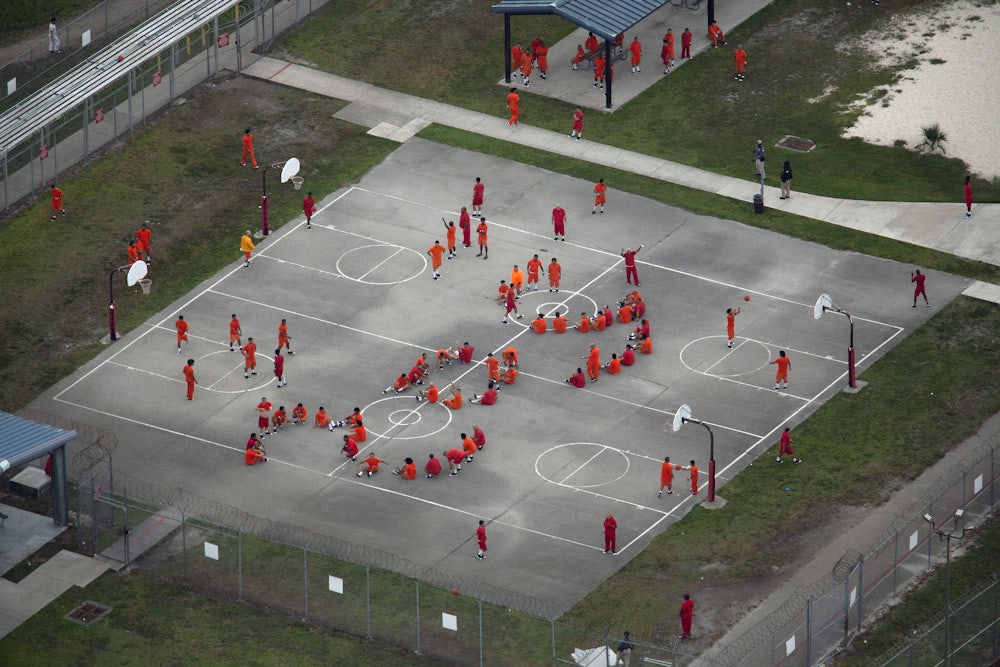On Monday, the Department of Defense announced that it had awarded the private company Acquisition Logistics a contract to build the largest immigrant detention facility in the United States—giving $1.26 billion, as Bloomberg reported this week, to a Virginia-based company that “doesn’t appear to have any experience with detention.” The proposed camp, meant to hold 5,000 people in tents adjacent to an airstrip, sounds more similar to the new ICE concentration camp in the Florida Everglades than to most other existing ICE detention facilities. With such facilities, dangerously inadequate and quickly erected, ICE is entering a new phase of rapid mass detention.
The news of this camp coincides with the release this week of a report from Human Rights Watch that offers a damning picture of what ICE detention has become since Trump assumed office in January. It is now routine for basics like access to time outside of cells and meetings with lawyers to be denied. Medical emergencies are dismissed or met with punishment. Lockdowns are declared to cover for ICE’s being short-staffed. One man reported that he and others were forced to eat “like dogs,” bent over with their hands restrained behind their backs.
The Acquisitions Logistics camp will be constructed within the second-largest Army base in the United States, Fort Bliss, near El Paso, Texas, and the southern border. While El Paso’s county jail currently imprisons immigrants on behalf of ICE, this new camp is very different. Like the Everglades camp, it is meant to intern thousands of people arrested by ICE outside the existing immigration detention system, in order to remove them from the country as swiftly as possible. Defense Secretary Pete Hegseth approved plans to use part of the base for a new immigration detention facility in March, and two weeks later, Stars and Stripes reported that Army engineers were “removing shrubs and leveling sand on a desolate 60-acre stretch.” ICE is now prioritizing such mass tent camps, The Wall Street Journal reported, “because it allows them to create large numbers of new beds concentrated in a few locations, rather than finding smaller numbers of jail cells scattered around the country.”
If built as planned, the Fort Bliss camp would be big enough to hold roughly 10 percent of the nearly 57,000 people that, as of July 13, ICE currently has locked up in detention facilities across the United States. That’s close to the highest number on record the government has ever held in immigration detention in U.S. history. Of course, ICE is tasked with keeping that number growing, and it’s doing so, according to data obtained and analyzed by the Transaction Records Access Clearinghouse. With each passing month of Trump’s second term, ICE has been arresting and detaining thousands more people.
It seems unlikely, however, that any contractor has the capacity to build and staff camps at a speed that can match the extraordinary pace at which the Trump administration wants ICE to work. “I am deeply skeptical of this small contractor’s ability to get the hundreds of staff necessary to operate a detention complex of 5,000 beds,” said Aaron Reichlin-Melnick, a senior fellow at the American Immigration Council. Not only does Acquisition Logistics not have experience in detention, according to Bloomberg, this government contract is “by far the biggest ever” for the firm.
ICE detention facilities vary greatly. Some are purpose-built and privately operated “processing centers” incarcerating a thousand people or more. Others are federal prisons authorized to jail people for ICE alongside other prisoners. A detention site can even be just a few dozen cells that a county jail rents to ICE. But whether ICE has built upon existing carceral infrastructure or is doling out contracts for private prison companies to make more, it is clear that the agency is locking up far more people than it has room for.
Detention centers and camps, distinct as they appear, may also share certain brutal features, including tents. When ICE jailed hundreds more people than space allowed at the Krome North Service Processing Center in Miami, operated by Akima Global Services, it put up a “soft-sided structure”—a large outdoor tent to hold 400 people. In early June, dozens of people jailed there protested their confinement in the recreation yard, forming the letters “SOS” and the word “LIBRE” with their bodies. Some weeks later, tents went up at a site about 30 miles away in the Everglades, dubbed “Alligator Alcatraz”—an American concentration camp. On June 26, a 75-year-old Cuban man died at Krome. He was the thirteenth person to die in ICE custody this year.
Krome’s conditions are “abusive and degrading,” according to the new Human Rights Watch report:
Individuals described prolonged confinement in frigid, overcrowded processing cells without bedding, adequate clothing, or access to hygiene. Women were also detained there for processing despite its being a male-only facility. They had no showers or privacy, and some were exposed to voyeurism by male detainees. This processing took place over a matter of days, not hours. Overcrowding persisted beyond intake, with cells holding more than double their intended capacity.
Those interviewed by HRW described punishing days and nights in ice-cold cells, sleeping on the floor without bedding or proper clothes. At times, ICE crammed 30 people into one small cell. The lights were always on. There would be a single toilet in a cell, without any privacy. One woman said she and her cellmates asked for cleaning supplies to clean their single filthy toilet for themselves, to which officers responded sarcastically, “Housekeeping will come soon.”
Despite ICE’s efforts to stop them, people inside Krome and numerous other detention sites have been able to get documentation of conditions and rights abuses out to the public. In New York, videos shared with the press by the New York Immigration Coalition show an emerging pattern: Here too, ICE is using cells that were meant to hold people for a matter of hours to keep them detained for days or more. People are forced to sleep next to toilets, without adequate clothing or bedding. (ICE claims that there is no detention center in this building, and denies charges of inhumane conditions.) In Massachusetts, at an ICE office in Burlington that is now similarly serving as a detention facility, one woman who was recently released from there described a similar situation: a freezing room where women had to sleep on the floor, a single toilet. “We slept close and huddled together—the line of women reaching all the way to the bathroom,” she told WBUR this month.
In light of these very similar stories, along with the questionable new contract for a concentration camp in Texas, it is not difficult to conclude that the current conditions in ICE detention centers are an intentional part of Trump’s promised “mass deportations,” even as they show how weak those plans are. Unable to fully deliver on mass deportation, ICE is ramping up its precursor: mass detention. Perhaps the administration still lacks the coordination and capacity to carry out mass deportations, which were always meant to be punitive, always intended in part—if not primarily—as a cause for Trump’s supporters to rally around. Each detention center’s abuses exposed, each shoddy new camp toured, fulfills Trump’s promise to scapegoat and punish immigrants. This fact does not undermine the importance of recording the brutal realities people face in these jails, “processing centers,” and camps, especially when the stories are told from their own point of view. The accounts may help reveal something more: that there is no “humane” solution to mass detention—a project that violates people’s dignity by design—without its abolition.






